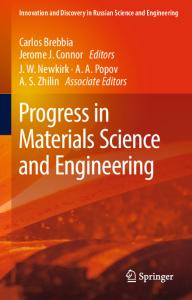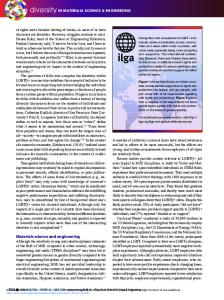Materials Science and Engineering Education
- PDF / 1,582,231 Bytes
- 4 Pages / 576 x 777.6 pts Page_size
- 107 Downloads / 438 Views
18
rials to behave predictably and "intelligently"—to sense external stimuli and respond desirably. The ability of materials scientists and engineers to process materials economically is becoming more and more important. Addressing environmental issues related to the elimination of harmful gases and waste products is also becoming an integral part of the competitiveness and viability of materials processing. The availability of energy-efficient methods for recycling may become a deciding factor for the use of a material in the future.
The expansion and diversity of MSE programs and employers' expectations present quite a challenging dilemma for materials educators. For example, of 70 billion pounds of plastics being produced annually, less than 5% is being recycled; the rest is disposed of as waste. In regions such as southern Florida, the highest peaks are landfills made of waste materials that would have been recycled if proper processing techniques were available. The traditional demand for improved materials properties and performance enabling new technologies has expanded to include their globally competitive synthesis, processing, and manufacturing in an environmentally benign manner. The latter requires special emphasis on "processing" while training and educating materials scientists and engineers. For brevity, the term "processing" is used
here to signify the synthesis-processingmanufacturing continuum needed to engineer, or create, materials from an atomic-scale level all the way to the economical production of the end product. For an optoelectronic application, the continuum may lead to the fabrication of a nanoscale device, but for structural applications, it may lead to the fabrication of multi-ton I-beams. Another important feature of MSE is its diversity, which allows scientists and engineers with different educational and training backgrounds to work collectively in response to societal demands. This diversity is also reflected by the industries and organizations who employ MSE graduates. For example, the recent MSE graduates of the University of Florida have been employed by aerospace, auto, biomedical, ceramics, chemical, electronic, metals, optical, pharmaceutical, polymers, and power industries, as well as federal and private research laboratories, in positions ranging from production to research, supervision to materials selection and quality control. Each industry has different expectations from these graduates. For example, when asked why MSE graduates were hired instead of traditional chemists or chemical engineers, a chemical company responded that the company sees MSE graduates as the glue which holds everybody together— from basic scientists on one side to the hardcore engineers on the other. As a materials practitioner, I would have preferred the use of the term "matrix" rather than "glue" to describe the role of MSE graduates. Nevertheless, it indicates that some of our graduates are taking key interdisciplinary positions which are considerably different from those of a few decades ago
Data Loading...











